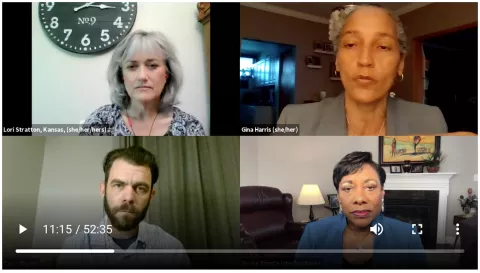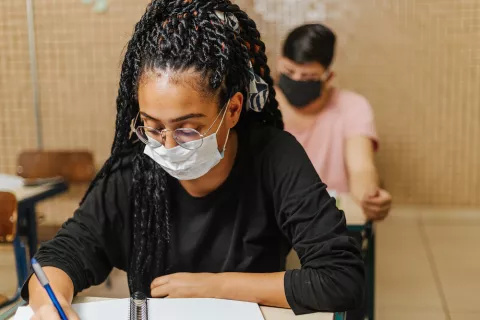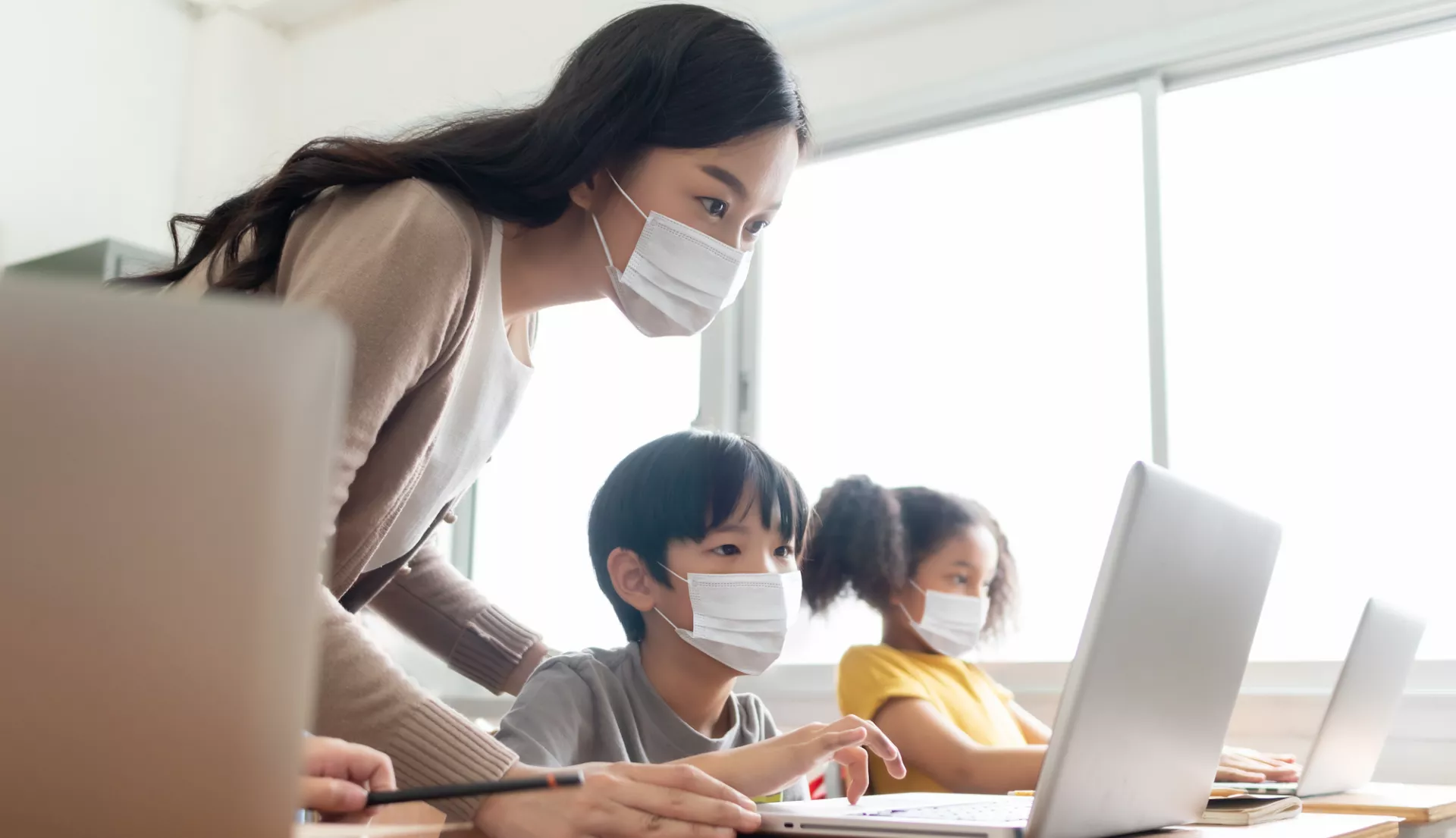Key Takeaways
- Social-Emotional Learning (SEL) must be prioritized.
- Educators will find creative ways to accelerate learning to meet individual student needs.
- Schools need funding to address mental health, crumbling infrastructure, and institutional racism.
The coronavirus pandemic clarified the unmet needs of our students and schools and deepened the many inequities that have existed for decades, but it also created opportunities to address the problems facing education. Those solutions were discussed during a panel, Learning Beyond COVID-19: Obstacles and Opportunities, at the Education Writers Association’s 74th National Seminar.
The panel was moderated by NPR correspondent and senior editor Cory Turner and featured National Education Association President Becky Pringle, Illinois middle school climate and culture coach Gina Harris, and Kansas high school English teacher Lori Stratton.
Turner kicked off the panel by asking the educators about the first hurdle they had to overcome during this pandemic year, which Harris said was having to leave school, leave the classroom and reimagine what it meant to reconnect with students in a virtual setting.
Stratton said that she and her colleagues had figure out how to tune out the negativity that was going on in the outside world and focus on the students. Rather than absorbing the criticism and complaints about virtual learning, she said they “needed to focus on what teachers were doing amazingly well.”
Pringle agreed. As a science teacher, it was especially difficult for her to hear from people who didn’t believe in science.
“We needed to listen to the science,” she said. “We needed to protect our students. We needed them to be safe and healthy.”
What that required, said Pringle, was cutting through all the noise and and making sure everyone understood that it was important to not only follow the science and listen to infectious disease experts, but also listen to the educators who know best about the way to provide equitable opportunities for all students to learn.
Social and Emotional Learning
Turner said there’s been a lot of media focus on the toxic stress experienced by students, and that many parents are more worried about the stress than about lost learning opportunities. He asked if we should be equally focused on making kids feel comfortable as we are on curriculum.

The answer: a unanimous yes.
“Students can’t learn when they’re stressed,” Pringle said. “We have to listen to them, talk to them, and understand how they are experiencing this world in this moment, which is different from our experiences. For our students to be successful, we have to consider the whole student.”
She pointed to the brain science behind social-emotional learning (SEL) that shows its enormous impact on student outcomes.
As a yoga, mindfulness and SEL administrator, Harris recommends that educators take time throughout the day to stop, breathe, and do emotional check-ins. It allows students to take a step back and see what the work is before them, but also to connect and build relationships with their classmates and educators.
“You’d be amazed at what one moment of breathing can do, or ten minutes of sharing circles,” she said. “SEL goes so far in helping students feel supported.”
Building Relationships
Stratton worked for six months in a virtual setting with high school juniors and seniors and she even has a sweatshirt that says “Zoom University.”
She said she started building relationships from day one and connecting with her students even in the virtual setting because, she said, “teaching is relationship building.”

“We became experts over time in how to connect with students virtually, because that’s what we do when we teach, so it didn’t feel like starting from scratch when they returned to the building,” she said. “The first week or two it was pretty quiet in the hall and students weren’t talking a lot, but by week three, it felt more normal. Students were ready to be back; they were ready to have those relationships.”
Pringle recently visited an elementary school and one of the Kindergarten teachers said at first her students only looked at her, they never looked around at their classmates because they were so used to looking at their teacher on the screen. So she took a moment to tell them to look around at each other.
“We need to focus on social skills, especially for our young ones who haven’t been in school for very long, or at all,” she said. “We need to focus on how students interact with each other.”
Creating Learning Opportunities
Tuner said that education reporters are trying not to use the term “learning loss.” But he asked the panelists how we can talk about closing opportunity gaps in a constructive way.
Pringle said that the phrase “learning loss” is inaccurate.
“Students are learning all the time,” she said.
The question is, what do they need to get to the next level of their academic journey?

“We need assessments that give us data in real time that tells us where students are academically, socially and emotionally, and we need the resources so that all students can learn at the highest level," Pringle said.
Harris said she worked with a number of students who excelled this year. Some were students who had previously struggled academically, but did better during the pandemic, they told her, because they weren’t as distracted during distance learning.
The fact that some students were able to thrive, Harris said, reminds us that we need to recognize individual student needs.
“The fact that some kids learned better virtually provides us a real opportunity to develop new and inventive ways to help fill gaps.”
Diving Deeper
Time was experienced differently during the pandemic, Stratton said, and her students, most of whom were home alone for most of the day, had a lot more time to “really dig into their research.”
“My students spent a long time designing their own research project that allowed us to develop their research skills in depth,” she said. “We accelerated learning by rethinking the curriculum. One of my students researched how COVID-19 affected the prison population and really got into it and produced amazing stuff.”
Pringle said that many of the strategies used during the pandemic educators have been talking about for a long time – one is called “learner centered education.”
“Students can’t learn when they’re stressed. We have to listen to them, talk to them, and understand how they are experiencing this world in this moment, which is different from our experiences." - NEA President Becky Pringle
This year she saw students working with each other on interactive, project-based learning that reflected all that was happening in the world – the science of the pandemic, the fight for racial justice, the stress of watching the murder of George Floyd and the white students who also joined in protest.
“I can only imagine how that came out in our students’ papers,” she said. “What an opportunity to dig into those critical thinking skills.”
What Educators Need Going Forward
Turner asked the panelists what educators need going forward to close gaps and improve equity, and they agreed that we need more trained social workers and counselors to provide mental health services, we need to address infrastructure, particularly in communities where buildings are literally crumbling and their air quality is dangerous, and we need to address institutional racism that has marginalized students and created enormous equity gaps.
“With the money the Biden administration is promising, we need to invest in our schools to build new systems that get at the institutional racism that not only exists in our educational system but in all the systems that surround it, such as healthcare, housing, nutrition, all of it,” Pringle said. “We must address institutional racism so that all of our students have what they need to learn.”





